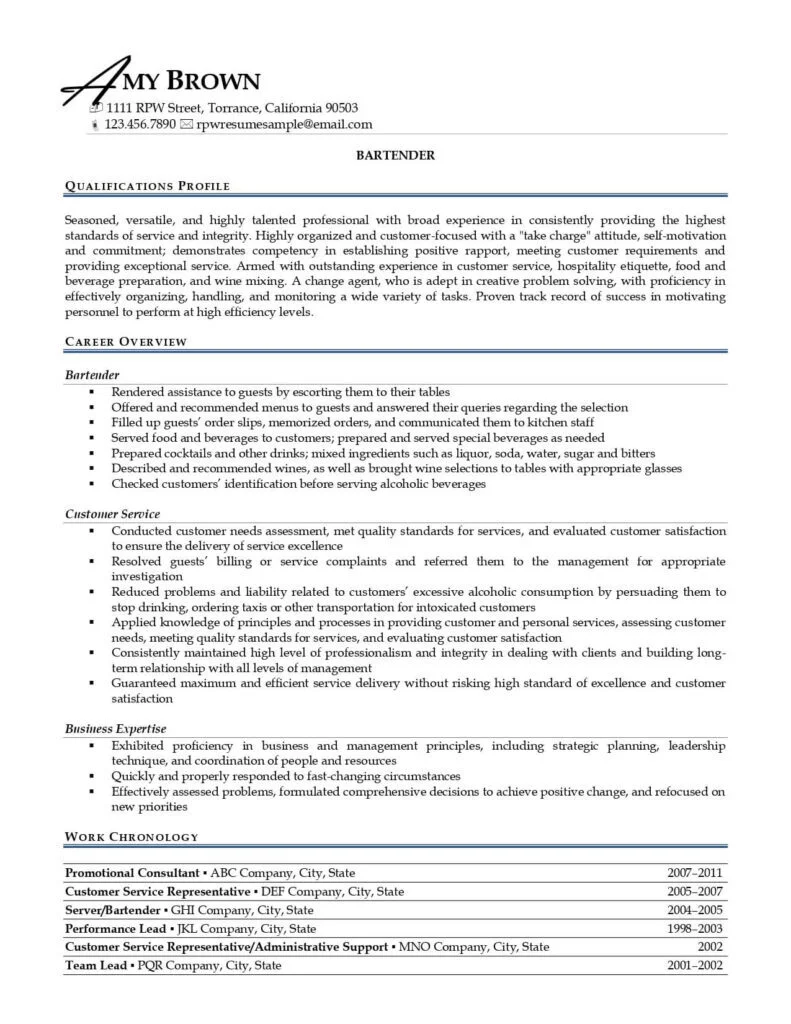As a bartender, you have the power to create memorable experiences for your patrons through your craft. Whether you’re shaking up classic cocktails or inventing new beverages, your ability to mix drinks and engage with customers is what sets you apart. But in a competitive industry like bartending, how can you ensure that your resume stands out from the crowd?
With numerous applicants aiming for coveted positions at bars, restaurants, and lounges, it’s essential to have a compelling resume that showcases your expertise and personality. Unsure if you can make this craft? Don’t worry! In this post, we’ll provide you some background information about bartenders as well as advice on how to write a bartender resume that will catch the eye of hiring managers and land you those coveted job interviews. Read on.
What is a Bartender?
A bartender is a highly skilled professional, expert at mixing and serving a wide variety of alcoholic and non-alcoholic beverages in bars, restaurants, hotels, and other establishments. They have a solid understanding of the many types of alcohol, ingredients, and mixology techniques, which allows them to create a vast range of beverages, while making sure that each drink looks gorgeous.
Along with their expertise in mixology, bartenders also excel at giving outstanding customer service and are well-versed in the rules and procedures of bars.

What are the Duties of a Bartender?
While a bartender’s primary responsibility involves producing and distributing beverages, their active role extends far beyond the bar counter. Other everyday responsibilities performed by these outstanding individuals include:
- Handle the preparation and serving of various drinks to customers, including cocktails, beers, wines, and non-alcoholic beverages.
- Foster a friendly and welcoming atmosphere for customers, while handling any inquiries and delivering exceptional service experience at the bar.
- Monitor beverage inventory, including alcohol, mixers, and garnishes.
- Place necessary orders to replenish supplies to ensure that popular drinks are readily available.
- Ensure the bar is clean, hygienic, and inviting for customers.
- Manage payments and handle cash as needed.
- Work closely with barbacks, servers, and other staff members to ensure smooth bar operations.
- Assist in training new employees and maintaining a cohesive work environment.
- Comply with established rules and regulations for alcoholic drinks and other food and beverages.
How Do You Become a Bartender?
There are a number of crucial steps you may take to start an exciting career as a successful bartender. Some of these include:
Earn a high school diploma
While a college degree isn’t required to become a bartender, you should have a high school diploma or GED. And if you want to increase your chances of being taken into consideration for this role, an associate or bachelor’s degree in hospitality management and culinary arts will make you stand out.
Enroll in a bartending school
Consider enrolling in a bartending course or school if you want to work as a bartender. These courses teach you the essentials of bartending, including drink recipes, customer service techniques, and responsible alcohol service.
Obtain required certifications
Certain certificates, such as the ServSafe or Responsible Service of Alcohol (RSA) certifications, may be required by some establishments for bartenders. These credentials demonstrate your understanding of safe alcohol service procedures which can greatly enhance your chance of securing an interview.
Gain practical experience
Look for chances to get hands-on experience in the field. Entry-level positions in bars, restaurants, or clubs are one way to do this. Start out as a waiter or barback while expressing an interest in becoming a bartender. By applying for this position, you can also learn from and work with seasoned bartenders.
Practice mixology skills
Try out several drink recipes and hone your mixology techniques at home or at a bar. Learn how to shake, swirl, muddle, and garnish drinks, as well as how to pour precise proportions.
What to Include in Your Bartender Resume
Effectively showcasing your abilities and experience is crucial when applying for bartender jobs. To do that, your bartender resume should include the following section:
Contact Information
Begin your bartender resume with your complete contact information, such as your name, mailing address, phone number, and email address. If you have a LinkedIn profile or a personal website, include a link to it.
Specific Target Job Position
Also known as the career tag, this information is typically displayed immediately after your contact information. This section is where you indicate your target post to tell companies of the employment position you’re applying for.
Qualifications Profile
A recruiter often has only a few seconds to evaluate your resume, so it’s critical to write an effective resume summary that highlights your career objectives and what you can provide to the position. Therefore, in a brief statement, demonstrate your enthusiasm for mixology, ability to communicate with clients, and commitment to providing outstanding service to capture their attention.
Expert Tip:
When creating your resume, avoid utilizing resume objectives. Instead, use attention-grabbing headings and headlines on your bartender resume to catch the hiring manager’s attention.
Skills Section
Create a separate section to outline your primary skills to help the hiring manager gain a quick overview of your skills and abilities. Cover both hard and soft skills, as well as any technical aptitude and specialized bartending skills such as:
Hard Skills
- Cocktail Preparation
- Mixology Techniques
- Flair Bartending
- Upselling
- Cash Management
Soft Skills
- Customer Service
- Communication Skills
- Teamwork and Coordination
- Flexibility
- Problem Solving and Critical Thinking
Technical Skills
- Point-of-Sales (POS)
- Bar Inventory System
Related Article:
Professional Experience
Outline your bartending experience, starting with your most recent or current position. Include the name and address of each business, as well as your work title and dates of employment. Provide a succinct summary of your duties, stressing your abilities to produce innovative drink mixes, conduct cash transactions, keep the bar area clean, and form excellent connections with clients. Whenever feasible, quantify your accomplishments, such as growing sales or receiving great customer feedback.
Education
Include your highest level of education, such as a high school diploma or college degree. Include the name of the institution, the degree obtained, and the dates of completion. If you have completed any courses related to bartending or hospitality, mention them as well.
Professional Development
If you have completed any licenses, certifications, or relevant training programs, include them in this section to strengthen your application.
Additional Sections for Your Bartender Resume
You can further strengthen your credentials by including any additional pertinent information in a separate area, such as awards, volunteer work, or involvement in industry events.
How to Write Your Bartender Resume
Crafting an exceptional bartender resume requires effectively highlighting your qualifications with clarity and conciseness. To achieve this, follow the writing techniques and latest resume trends provided below.
1. Choose the resume format that fits your experience.
If you have extensive bartending experience, a chronological format is ideal for showcasing your skills. However, if you are new to the industry or a recent graduate, there are alternative resume formats that may suit you better, such as functional, targeted, or combination formats. Regardless of the format you choose, make sure your resume highlights your expertise, customer service abilities, drink knowledge, and any relevant certifications.
2. Make sure to use a clean resume layout.
Make your bartender resume more appealing to hiring managers by using professional resume layouts and font styles. This would facilitate the evaluation of your resume by resume-scanning software, potentially increasing your chances of passing the applicant tracking system (ATS).
3. Show off your qualifications on your resume summary.
Put up your finest elevator pitch on your profile area because you just have six seconds to catch the recruiting manager’s eye. Show off your knowledge and talents that make you the best applicant for the position.
3. Highlight your relevant skills.
Since you’re applying for a customer service position, you need to emphasize your interpersonal abilities. Show that you have the ability to serve all of your customers in addition to being adept at making drinks. You should also add industry-specific keywords and a combination of hard and soft skills to demonstrate your ability to perform a variety of bar activities.
5. Proofread your document.
Before submitting, make sure to read your bartender resume numerous times. This makes it easier to check, detect, and correct issues such as grammar and punctuation errors. Keep in mind that maintaining a flawless resume can increase your chances of getting job interviews.
Bartender Resume Example
To give you a better sense of what a strong bartender resume should look like, check out the bartender resume example provided below:

Craft a Bartender Resume That Reflects Your Unique Skills!
Much like the art of mixing drinks, bartenders possess the skill of creating a seamless and enjoyable experience for customers. However, capturing these skills and expertise on paper can pose a challenge to many bartenders.
And if you are one of those who find it challenging to properly market their credentials in a way that attracts potential employers? No more worries! You can get help from professional resume writers to create a compelling resume. Our authors will help you not only with a top-notch resume writing service but also their skills and understanding in the industry that can surely help you land your ideal job in no time.
Contact us today, and let us help you succeed in your job search!








